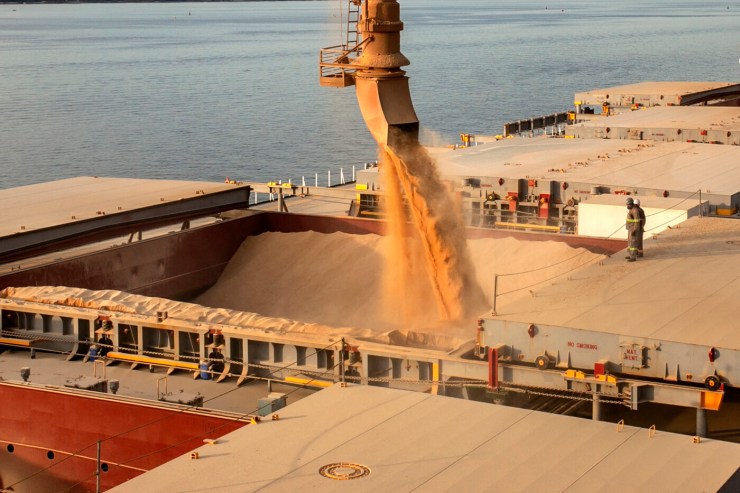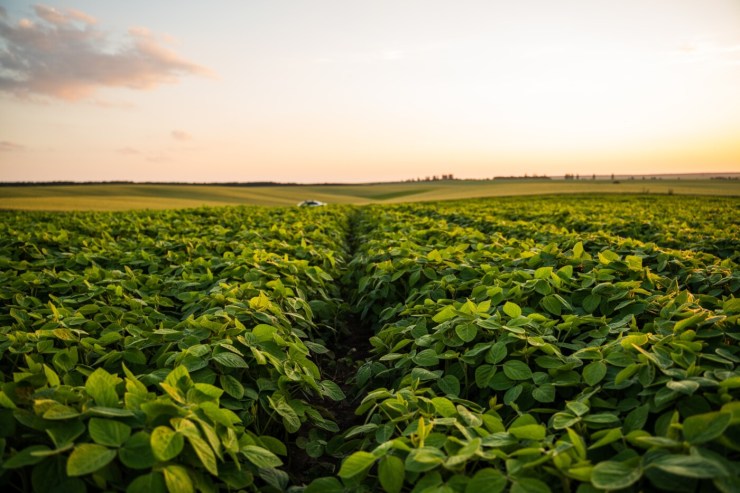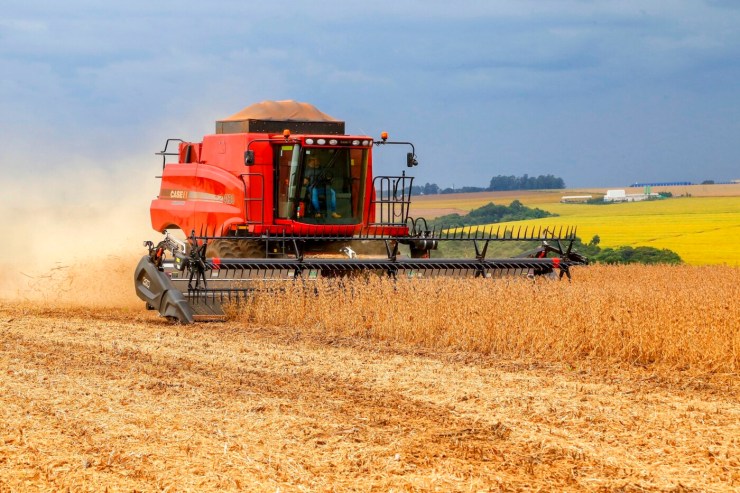Brazil is expected to remain the world's leading soybean producer in the 2025/26 harvest, with a record production estimate of 174 million tons, according to Itaú BBA's Agro Consulting. This figure is 4% higher than the previous season and roughly in line with the United States Department of Agriculture (USDA) projection of 175 million tons.
Brazil's performance stands out in a global scenario of moderate growth, with global production estimated at 427 million tons, a modest increase of 1% compared to 2024/25. "Brazil is expected to be the only major producer to experience significant growth in soybean production next season. This is due to the combination of a slight expansion in area, productivity gains, and good weather conditions in the main producing regions," assesses Francisco Carlos Queiroz, agricultural consultant at Itaú BBA.

Itaú BBA agricultural consultant, Francisco Carlos Queiroz: If the weather cooperates, we will have another very robust harvest in Brazil” – Photo: Disclosure/Itaú BBA
The consultancy estimates that the area planted with the oilseed will reach 48.3 million hectares, an increase of 1.5% compared to the previous cycle. Although modest, the growth continues a trend of 18 consecutive harvests of expansion. "In the last four years, the area grew by 19%, but now the growth will be more limited," observes Queiroz, highlighting that high production costs, especially fertilizers and interest rates, are significant limiting factors.
The expected average yield is 3.6 tons per hectare, favored by modern technologies and a promising climate outlook. Climate models indicate neutrality in the coming months, which should ensure regular rainfall in key regions such as the Central-West. "If the weather cooperates, we will have another very robust harvest in Brazil," Queiroz points out.
Demand in transformation
On the demand side, the outlook is also positive. Soybean meal remains a key ingredient in animal nutrition, fueling the growth of the meat and dairy supply chains. But the biggest innovation is the use of soybean oil as a base for biofuels, especially biodiesel and renewable diesel.
"Biofuel production is becoming the main driver of soybean demand growth. There's a global need to decarbonize economies, which has driven investment in this sector," Queiroz says, highlighting the trend toward increased processing of the grain for oil extraction, which generates positive effects across the entire soybean chain.
USA and Argentina: more restrained scenario
In the United States, production is expected to decline to 118 million tons, 1% below the previous harvest. Despite projected productivity of 3.5 t/ha (up 3.5%), planted area fell by 4%, pressured by competition from corn, which promises greater profitability this season. "Planting in the US proceeded quickly and under good conditions, with above-average rainfall in some regions," reports the consultant, emphasizing: "Productivity may be good, but we are still in the middle of the season. July and August will be decisive."
The warning comes from the tighter balance between supply and demand in the American market. "If there's a breakdown, the impact on prices on the Chicago Board of Trade (CBOT) could be significant," Queiroz assesses.
In Argentina, the estimate is 48.5 million tons, a decrease of 1% compared to the previous harvest, with a reduction of almost 5% in planted area. "Argentine producers tend to migrate to crops with higher expected returns, such as corn," comments the expert.
Global competitiveness and pricing

In a scenario of modest global growth and pressure on production costs, Brazil is poised to gain more market share. "With a record harvest and strong demand, Brazil remains a key player in the global soybean supply," explains Queiroz.
Despite this, he warns that the international market will remain sensitive to potential declines in American production. "Brazil can produce very well, but price behavior will continue to be tied to the perception of supply in the US," he emphasizes.
With planting in Brazil scheduled to begin in September, producers are entering the final stretch of decisions regarding cultivars, inputs, and investments. If forecasts are confirmed, the country could further strengthen its position as a global leader in soybean production, cementing the leadership it has achieved in recent years.
Global demand on the rise
The expansion in global demand for soybeans also contributes to optimism about the oilseed market. According to the Itaú BBA consultant, the average growth in global consumption over the last 10 years was 3% per year. However, the 2024/25 harvest is expected to end with a 7% jump in consumption, and for 2025/26, the projection is for growth of 4%, both well above the decade's average. "What's driving this acceleration are biofuels. Soybean oil has been gaining increasing importance in the production of biodiesel and renewable diesel. This movement creates a new level of demand, with structural impacts on the soybean market," explains Queiroz.
The USDA's projection for global crushing, the stage of processing grains to extract oil and meal, indicates an increase of 13.4 million tons, jumping from 353.2 to 366.6 million tons in the 2025/26 season. Soybean meal, in turn, is expected to see record demand, supported by the expansion of global meat production and competitive prices amid increased supply. "Meal remains the main protein input for animal feed, and the growth in chicken, pork, and beef production sustains demand for this raw material," comments the expert.
China remains the main consumer
 Responsible for approximately 30% of global soybean consumption, China will continue to be the world's largest importer of the grain. After a slight decline in purchases in 2024/25, driven by high inventories, the Asian country is expected to resume a stronger pace in the following season.
Responsible for approximately 30% of global soybean consumption, China will continue to be the world's largest importer of the grain. After a slight decline in purchases in 2024/25, driven by high inventories, the Asian country is expected to resume a stronger pace in the following season.
The USDA forecast points to imports exceeding 110 million tons in 2025/26, with total consumption projected at 133 million tons, an increase of 4.8% over the previous cycle. "Even with the economic slowdown and the Chinese government's attempts to reduce the use of soybean meal in animal feed, demand for soybeans is expected to grow above the historical average," says Queiroz, highlighting that urbanization and changing food consumption patterns continue to drive protein consumption in the Asian country.
Besides China, other demand centers are gaining prominence, such as the European Union, the Middle East, Southeast Asia, Iran, Bangladesh, and Pakistan. "These markets have seen an increase in animal protein consumption, which naturally drives soybean and soybean meal consumption," adds the Itaú BBA consultant.
Global stocks
Despite the increase in production and consumption, global soybean stocks are expected to remain stable in 2025/26, at around 125 million tons, according to the consultancy's estimates. This level, combined with strong demand, should result in a slight drop in the global stock-to-use ratio, from 31% to 30%. "This is a point of concern. Lower stocks tend to increase price volatility. If there are any adverse weather conditions in the main producing regions, especially the US, the impact on international prices could be significant," Queiroz emphasizes.
In addition to production and consumption factors, political and regulatory factors continue to influence the soybean market. Issues such as biofuel policies, agricultural subsidies, trade agreements, and environmental restrictions also influence market decisions. "A clear example is the trade war between the United States and China, which directly impacted soybean prices on the Chicago Board of Trade and increased the premiums paid in Brazil," the expert notes.
Keep an eye on the weather and prices
With a scenario of sustained demand growth, relatively stable inventories, and expectations of robust production in Brazil, the soybean market enters the 2025/26 harvest with positive fundamentals. However, volatility will remain, requiring increased attention from producers and market participants. "The climate in the US and Brazil, in addition to the pace of purchases from China, will be the main factors influencing prices in the coming months," says Queiroz, noting that the expectation is for a good profitability environment for those who produce efficiently.
Grain appreciation trend
 The large global supply, led by the record Brazilian harvest and the increase in final stocks in the United States, put pressure on international soybean prices in the 2024/25 season. As a result, average future prices were below those recorded in the previous cycle.
The large global supply, led by the record Brazilian harvest and the increase in final stocks in the United States, put pressure on international soybean prices in the 2024/25 season. As a result, average future prices were below those recorded in the previous cycle.
However, the downward trend is beginning to lose momentum. For the 2025/26 harvest, the market is already projecting appreciation in futures prices in Chicago, reflecting a tighter stock-to-use ratio, estimated at 30%. "The market is beginning to reprice soybeans based on fairer fundamentals, and this has been reflected in soybean oil prices," explains Queiroz.
The U.S. Environmental Protection Agency (EPA) has proposed increases in biodiesel blending targets of 67% for 2026 and 75% for 2027. Furthermore, the new regulation proposes limiting decarbonization credits generated from imported feedstocks, such as used oil from China and beef tallow from Brazil. "In practice, this change favors domestic soybean oil and stimulates domestic demand in the U.S., raising prices," says the consultant.
This scenario reinforces expectations of firm soybean prices in Chicago, especially considering the tighter US balance sheet, the influence of the weather during July and August in the Midwest, as well as geopolitical uncertainties and the evolution of the South American season.
In Brazil, prices remain close to export parity, supported by the exchange rate and premiums. "Even with the 10% drop on the CBOT between June 2024 and June 2025, soybeans fell only 3.4% in reais at the Port of Paranaguá, demonstrating some resilience in the domestic market," Queiroz notes.
Rising costs and pressured margins
Despite the more favorable price environment, producers are expected to face higher production costs in the 2025/26 harvest. Itaú BBA expects a 8% increase in total operating costs, driven primarily by fertilizers, which are expected to rise by around 20%. "Potassium and phosphorus have accumulated increases of almost 20% in the last 12 months. As a result, the exchange rate has worsened, meaning each ton of soybeans buys less input than it did previously. This directly pressures producer margins," the consultant emphasizes.
In southeastern Mato Grosso, despite higher-than-expected productivity in the 2024/25 cycle, high financial costs due to high interest rates reduced net profitability. Regions such as the South and Mato Grosso do Sul, where productivity fell short of expectations, faced an even more challenging scenario.
On the other hand, the exchange rate may offer some relief. "If the real doesn't appreciate much in the coming months, as projected by Itaú Unibanco's economic research team, this will likely favor soybean pricing in reais," says Queiroz.
Rising costs, however, limit the incentive for further acreage expansion. "Even though the weather is favorable, with regular rainfall forecast for the Midwest, the increase in planted area should remain moderate," says the consultant.
Lower profitability, firm prices

Even with projected higher average prices for 2025/26, producers' profitability is expected to become tighter, given rising costs. Soybean pricing in reais will be influenced by three main variables: prices in Chicago, exchange rates, and export premiums. "The market is more volatile, and this requires producers to pay greater attention to risk management," recommends Queiroz, noting: "With so many factors at play, from climate and geopolitics to energy policy decisions in the US, the use of hedging tools becomes even more strategic."
Alternatives include futures pricing and the use of derivatives to hedge against losses. "Protecting margins in a more uncertain environment can make all the difference to the financial sustainability of a business," Queiroz points out.
Access to the digital version of Bovinos, Grãos & Máquinas is free. To read the full version online, click here. Happy reading!




